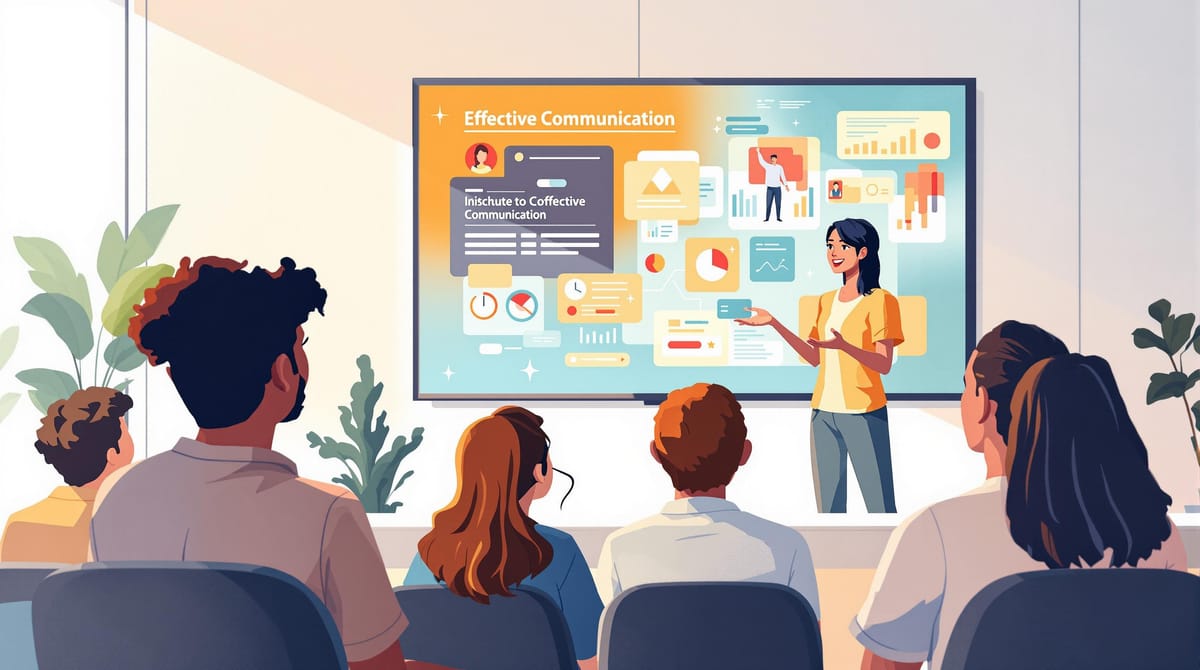What Makes Audiences Tune Out?
Engage your audience effectively by avoiding common pitfalls like irrelevance, jargon, and dull delivery. Learn practical tips to maintain attention.

Want to keep your audience engaged? Avoid these three common pitfalls:
- Irrelevant messages: If your content doesn’t address what matters to your audience, they’ll lose interest.
- Overuse of jargon: Too much technical language creates a barrier and alienates listeners.
- Dull delivery: A monotone voice or lack of energy makes it hard to hold attention.
How to fix it:
- Tailor your message to your audience’s needs.
- Use relatable stories to make your points memorable.
- Keep sessions interactive with questions, discussions, or tools like polls.
Pay attention to body language and verbal cues for signs of disengagement, and adjust your approach to reconnect with your audience.
3 Ingredients To Increase Audience Engagement
Why Audiences Stop Listening
There are three main reasons why people stop paying attention: relevance, language, and delivery.
Irrelevant Message
If you're a leader and your message doesn't address what your audience cares about, they'll mentally check out. They want to know, "How does this matter to me?"
Overuse of Technical Jargon
Using too much technical language can alienate your audience. It creates a wall between you and them, making it harder for them to stay engaged.
Dull Delivery
A monotone voice or a lack of variation in your pace can quickly bore listeners. Without energy or variety, it's hard to keep their attention.
Spotting a Disengaged Audience
Catching signs of disengagement early gives you the chance to adjust your approach and regain attention.
Body Language Clues
- Crossed arms or slouched posture
- Little to no eye contact
- Constantly checking watches or phones
- Fidgeting or shifting in their seats
But it’s not just about body language - verbal cues also reveal a lot.
Signs of Low Engagement
- No hands raised or questions asked when prompted
- Silence after key discussion points
- Few reactions or nods to important messages
- Hardly any note-taking
These signs suggest your message or delivery isn’t connecting. Try switching up your tone, adding relatable examples, or increasing audience interaction.
Keeping Your Audience Engaged
If you notice your audience losing interest, use a mix of relevant content, engaging stories, and interactive elements to bring them back.
Match Content to Your Audience
Understand who you're speaking to by researching their background, challenges, and goals. Tailor your content to meet their needs:
- For senior leaders: Offer a high-level overview with strategic insights.
- For subject-matter experts: Provide detailed technical analysis.
- For general audiences: Share practical summaries with clear, actionable takeaways.
Tell Stories That Connect
Use storytelling to make your points stick. Narratives can make ideas more memorable, build an emotional connection, and align your audience with shared objectives.
Make Sessions Interactive
Turn passive listeners into active participants by incorporating action-based learning. Guide them through cycles of inquiry, reflection, and action [3].
- Ask thought-provoking questions for group discussions.
- Set clear prompts and time limits to keep things focused.
- Invite participants to share their insights and plans.
For virtual settings, tools like breakout rooms, polls, and shared documents can help. Just ensure instructions are clear, and include checkpoints to track progress.
Speaking to UK Audiences
When addressing UK audiences, it’s important to consider their communication preferences. British audiences often appreciate a tone that blends professionalism with subtle humour.
British Language and Style
When communicating with a British audience, keep these cultural nuances in mind:
- Stick to British spelling and familiar vocabulary (e.g., organisation, programme).
- Use restrained language instead of exaggerated claims.
- Aim for a tone that’s formal yet approachable.
- Add self-deprecating humour where it feels natural.
- Avoid language that feels too pushy or overly focused on sales.
British audiences typically prefer:
- Tone: Calm, diplomatic, and never overly assertive.
- Humour: Light and self-deprecating, steering clear of sarcasm or aggression.
- Expertise: Quiet confidence, avoiding boastful or exaggerated statements.
- Questions: Thoughtful and indirect, rather than blunt or confrontational.
Local Examples and References
To resonate with UK audiences, use examples that reflect their local context. For instance:
- Refer to public sector organisations like the NHS to discuss topics such as leadership or organisational change.
- Highlight case studies from prominent British companies instead of relying on Silicon Valley examples.
- Showcase initiatives from across the UK, including London, regional business hubs, Scotland, Wales, and Northern Ireland.
When presenting data, use UK-specific formats:
- Figures in pounds sterling (e.g., £24,000).
- Dates in day-month-year format (e.g., 24 April 2025).
- Measurements in metric units (e.g., 37.5 km).
Conclusion
Avoid losing your audience's interest by blending focused storytelling with active engagement tracking. Effective engagement revolves around three key practices:
- Craft tailored stories to strengthen team trust and boost productivity.
- Use facilitation tools, such as thoughtful questions, prompts, and reflections, to maintain attention.
- Pay attention to audience cues and adapt your tone or content as needed.
The secret to keeping your audience engaged is building genuine connections through stories that speak directly to them. These methods work in any UK setting, whether in a boardroom or an online meeting.
FAQs
How can I adapt my message to keep different audiences engaged?
To ensure your message resonates with different audiences, it's essential to understand their unique needs, preferences, and expectations. Start by researching your audience - consider factors like their background, values, and communication style. This will help you craft a message that feels relevant and relatable to them.
When presenting, adjust your tone, language, and examples to suit the group. For instance, a technical audience might appreciate detailed data, while a broader audience may prefer stories or analogies to simplify complex ideas. Always aim to connect emotionally by addressing their challenges or aspirations, and encourage interaction to keep them engaged throughout.
By tailoring your approach, you can build stronger connections and ensure your message is both impactful and memorable.
How can I recognise and address disengagement during a presentation?
Spotting signs of disengagement during a presentation is crucial to keeping your audience engaged. Look out for body language cues like slouching, avoiding eye contact, or fidgeting. A lack of questions or interaction can also signal waning interest.
To re-engage your audience, try changing up your delivery. This could mean asking a thought-provoking question, sharing a relevant story, or incorporating a brief interactive activity. Adjusting your tone, pace, or visuals can also help recapture attention. Remember, being attuned to your audience's reactions allows you to adapt in real-time and maintain their focus effectively.
What types of stories help leaders connect with their audience?
Relatable stories that resonate with audiences often draw from personal experiences, shared challenges, or universal themes. For example, a leader might share a story about overcoming a professional setback, navigating change, or achieving a significant milestone. These narratives can foster trust and inspire action by demonstrating authenticity and shared understanding.
To enhance audience engagement, focus on stories that highlight common values, emotional connections, or lessons learned. Keep them concise, relevant, and aligned with the message you want to communicate. Thoughtful storytelling can transform your communication, helping you connect with your team, stakeholders, or clients on a deeper level.



